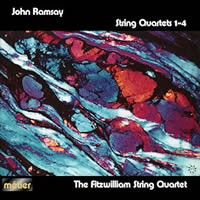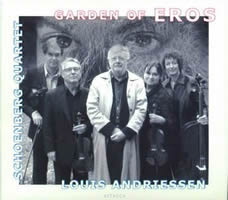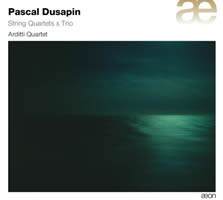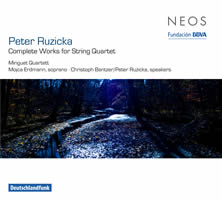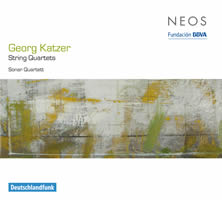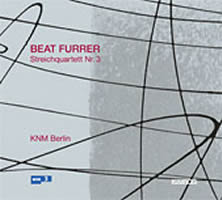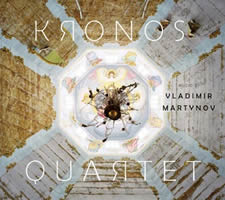String Theory 9: 30 Quartets, etc.
|
Grant Chu Covell [August 2012.]
John RAMSAY: String Quartet No. 1 (2001)1; String Quartet No. 2, Shackleton (2002)2; String Quartet No. 3 (2004)3; String Quartet No. 4, Charles Darwin (2009)4. The Fitzwilliam String Quartet: Lucy Russell1, 2, 3, 4, Jonathan Sparey1, 4, Colin Scobie2, 3 (vlns), Alan George1, 2, 3, 4 (vla), Heather Tuach1, 2, 3, 4 (vlc). Metier MSV 28528 (2 CDs) (http://www.divine-art.co.uk/). As we’d expect from a seasoned musician, Ramsay’s quartets reveal a deep understanding of and admiration for the genre’s giants. No. 1’s proportions and design neatly equate with Haydn, though the vocabulary mixes Bartók and Shostakovich. I also hear the vigorous melodic shapes I associate with Nyman, even though I’m sure Ramsay would prefer to keep minimalism and even modernism at arm’s length. The slow movement offers variations on Marie Bhodheach, a Gaelic song. Shackleton commemorates the composer’s close friend, a distant relation to the explorer and fellow geologist (Metier downplays Ramsay’s scientific career). Textures mimic Shackleton’s purported grumpiness, and flamenco gestures reflect the dedicatee’s work in Spain, however the overall mood is funereal and somber. The non-programmatic No. 3 explicitly wrestles with Mozart’s Dissonant, K. 465. The five-movement arch form contrasts tritone-distant keys and the finale employs the Fibonacci series. Commissioned to celebrate Darwin’s 200th birthday, the single-movement Fourth’s program is minutely detailed in the notes. Particles and gas form planets upon which life appears. Man evolves and music representing different religions leads to a combative fugue and thence to war culminating in apocalypse. A quiet epilogue reflects upon a barren planet’s unexpected beauty. Ramsay shies away from contemporary trends — his music is vastly more distinctive.
“Garden of Eros.” Louis ANDRIESSEN: Quartet in two movements (1957); Facing Death (1990); Garden of Eros (2002); …miserere… (2006). J.S. BACH: Prelude in b minor from the Well-Tempered Clavier, BWV 869 (arr. I. Stravinsky, compl. by L. Andriessen, 2006). Schoenberg Quartet: Janneke van der Meer, Wim de Jong (vlns), Henk Guittart (vla), Viola de Hoog (vlc). Attacca CD 29121 (http://www.attacca-records.com/). If you’re familiar with the Andriessen of Orkest de Volharding or later works for non-standard bands, it might surprise to know he’s written string quartets. Indeed, an eager 18-year-old penned the early two-movement quartet which reflects awareness of Bartók and Stravinskian neo-classicism. Jumping ahead many years, we find that Facing Death for amplified quartet (or sax quartet) avoids tradition with frenetic, perhaps overbearing bebop lines. Jazz also infiltrates Andriessen’s most traditional quartet, Garden of Eros, not only because it conceals the Dies irae. Eight variations in miserere quote himself and others. The Bach arrangement completes a Stravinsky fragment with occasionally wayward notes. These recordings were made in 2005 and 2007, before the ensemble disbanded in 2009.
Pascal DUSAPIN: Quatuor V (2004-05); Quatuor IV (1997); Quatuor III (1993); Quatuor II, “Time Zones” (1989); Quatuor I (1982, rev. 1996); Trio, “Musique fugitive” (1980). Arditti Quartet: Irvine Arditti, Ashot Sarkissjan (vlns), Ralf Ehlers (vla), Lucas Fels (vlc). Aeon AECD 0983 (2 CDs) (http://www.aeon.fr/). This Dusapin retrospective traverses contemplative maturity to fidgety exuberance. The First and the Trio dispatch eye-catching gestures with reckless abandon. No. 2’s 24 movements seek gravity. In contrast, the Fifth’s Eastern sound supplants extroverted agitation with lyricism. The Third and Fourth chart a predilection for absolute sound. The Arditti sculpt aggressively.
Peter RUZICKA: String Quartet No. 1, “Introspezione” (1969-70); String Quartet No. 2, “…fragment…” (1970); Klangschatten (1991); String Quartet No. 3, “…Über ein Verschwinden” (1992); String Quartet No. 4, “ sich Verlierend” (1996)1; String Quartet No. 5, “Sturz” (2004); String Quartet No. 6, “Erinnerung und Vergessen” (2008)2. Paul CELAN: 12 poems from “Zeitgehöft” (1976)3. Minguet Quartett: Ulrich Isfort, Annette Reisinger (vlns), Firmian Lermer (vla), Matthias Diener (vlc); Peter Ruzicka3 (speaker), Christoph Bantzer1 (speaker), Mojca Erdmann2 (sop). NEOS 10822/23 (2 SACDs) (http://www.neos-music.com/). In Ruzicka’s universe, music intertwines with words and memory. Texts may inform but not appear, or arrive disembodied. Each quartet bears a title. Others’ music may materialize modified to indicate faulty recollection or disintegration over time. Ruzicka’s seems preoccupied with Celan, Hölderlin and Mahler. In fact the composer offers 12 poems from Celan’s Zeitgehöft (programmed between the Second and Third quartets). Despite my rudimentary German, I was struck by the frequent multisyllabic, almost tongue-twisting words. The first three quartets arrive at Mahler via different episodic routes. No. 1 documents mental states during a psychedelic experience. Unclear whether this was actually written during such experimentation or if it’s meant to reflect altered states. Modernist splattering yields to a smattering of quotations, including Webern, Beethoven and Mahler (the booklet indicates Pfitzner I did not recognize). The Second reflects Celan’s suicide. Five terse epigrams eventually curl around the Adagio of Mahler’s 10th. The two-minute trifle Klangschatten commemorates publisher Alfred Schlee’s 90th. Incongruous bits from Mahler’s Ninth appear in the substantial and predominantly athematic Third. The Fourth requires a speaker (Valéry, von Hofmannsthal, Adorno, Wittgenstein, et al.), but the texts go their own way, like roadway billboards. The punishing Fifth (“Plunge”) is purely instrumental, reflecting temporal-state changes experienced while flying across the Atlantic. The seven-movement Sixth incorporates Hölderlin sung by soprano, and as with the Fourth, instruments and voice are often at odds. Despite Fischer-Dieskau’s appearance as speaker in the Arditti’s selection (ECM 1694), the Minguet Quartett survey is vastly preferable.
Georg KATZER: String Quartet No. 1 (1965); String Quartet No. 3 (1987); String Quartet No. 4, “tempi fragili” (2004). Sonar Quartet: Susanne Zapf, Kirsten Harms (vlns), Nikolaus Schlierf (vla), Cosima Gerhardt (vlc). NEOS 11020 (1 SACD) (http://www.neos-music.com/). Happily, Katzer is getting his due in these pages. Spanning nearly 40 years, these three quartets chronicle the last century’s styles. No. 1 adheres to tradition in a fast-slow-fast format with aleatoric and non-synchronized events. Both Nos. 3 and 4 are single movements. No. 3 employs non-standard sound production. Quartet No. 2 was neither published nor performed, its sketches having been absorbed into No. 4. The Third, requiring a tight ensemble, embodies motives suggesting Bartók and the whirling gestures in Berg’s mirror Rondo from Lulu. German reunification came between No. 3 and 4, and while the Third is perhaps less programmatic, the restless Fourth lunges and halts. While the notes suggest that post-GDR, Katzer may be more inclined to do as he pleases, his audience has diminished.
Beat FURRER: Streichquartett Nr. 3 (2004). KNM Berlin: Steffen Tast, Angela Jaffé (vlns), Kirstin Maria Pientka (vla), Ringela Riemke (vlc). Kairos 0013132KAI (1 CD) (http://www.kairos-music.com/). Kairos’ notes obliquely refer to Furrer’s prior two quartets from the 1980s as “products of an earlier creative phase,” i.e., when he practiced ubiquitous modernism. Now he’s crossed over to Lachenmann and Sciarrino, exploring frail textures and eschewing harmony. At 52 minutes, the vast Third warms gradually to reveal small-scale repetition amid obscured larger patterns. The work was intentionally created backwards, the opening conceived as a conclusion. The continual re-emergence of material suggests a failing short-term memory. An antique chorale emerges provocatively in the last third.
Vladimir MARTYNOV: The Beatitudes (1998, rev. 2006); Schubert-Quintet (Unfinished) (2009); Der Abschied (2006)*. Kronos Quartet: David Harrington, John Sherba (vlns), Hank Dutt (vla), Jeffrey Zeigler (vlc); Joan Jeanrenaud* (vlc). Nonesuch 529776-2 (1 CD) (http://www.nonesuch.com/). Martynov lingers over beautiful moments he fondles and kneads to the point of gummy worthlessness. Who hasn’t longed for a never-ending version of the slow movement in Schubert’s String Quintet? Martynov grants that wish. Is this about unresolved sexual tension or an unattainable pursuit of beauty? How strange that the Kronos delivers perhaps the last quartet to tackle either Schubert, or in the case of Der Abschied, Mahler. I envision an offstage coach: “Play more beautifully, damnit!” albeit to a negligible effect. Admittedly, the five-and-a-half-minute Beatitudes are gorgeous. Perhaps I have an allergy to too much sunshine. Whatever, I imagine this trifle becoming a wedding favorite. The two-movement Schubert paean’s second cello permits all former and current Kronos members to play together. Martynov itemizes Schubert’s twisting harmony through equally phrased repetitions. Changes startle, yet the second part flows more calmly than the first. The entire 23:22 ends as abruptly as the title suggests. The Mahlerian soup bubbles on for 40 minutes. Slow dissonance sets off the poignant original from which small gestures mutate. Perhaps you crave the Mahler’s return? Alas no, Martynov has moved on. Now that I think of it, the three pieces all end inconclusively. “String Quartets Vol. 1.” Rued LANGGAARD: String Quartet No. 2 (1918, rev. 1931); String Quartet No. 3 (1924); String Quartet No. 6 (1918-19); Variations on “Mig hjertelig nu længes” (1914, rev. 1931). Nightingale String Quartet: Josefine Dalsgaard, Gunvor Sihm (vlns), Marie Louise Broholt Jensen (vla), Louisa Schwab (vlc). Dacapo 6.220575 (1 SACD) (http://www.dacapo.dk/). Like his symphonies, Langgaard’s quartets straddle periods and genres. Do not attempt to guess at time frames or stylistic clues from chronology or sequential numbering. The most endearing idylls appear in later works, with the strangest moments surrounding them. Heard from afar, these quartets could be confused with salon fare. Up close they seem slightly deranged. The Second offers four postcards including a musical depiction of a passing train (predating Honegger’s Pacific 231). Langgaard’s most tender music, No. 2’s Landscape in Twilight and No. 6’s opening, marry hymns with alluring folk hints. The wandering single-movement Sixth abruptly changes moods as if following a storyline. The seven variations on the chorale “Oh sacred head, now wounded” call Beethoven or Mendelssohn to mind. I’m eager to hear the next volume(s).
[Previous Article:
Piano Factory 9.]
[Next Article:
Mostly Symphonies 20.]
|
